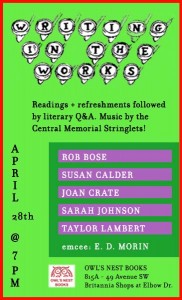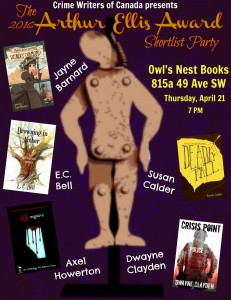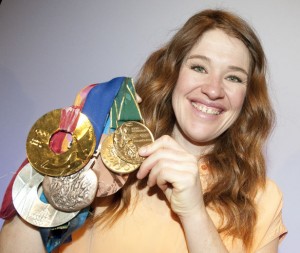In this week’s Calgary Through the Eyes of Writers author Caroline Adderson shows how you view things differently as an adult than you did as a child.
Migrants
This week’s Calgary Through the Eyes of Writers talks of someone, like me and many, many others – who moved to Calgary from elsewhere.
Writing in the Works
 I’m fortunate to be participating in two readings at the end of April. The Arthur Ellis Shortlist event arrives first – on April 21st – where I get to host the mayhem and try to keep those wild crime writers in line.
I’m fortunate to be participating in two readings at the end of April. The Arthur Ellis Shortlist event arrives first – on April 21st – where I get to host the mayhem and try to keep those wild crime writers in line.
A week later, on April 28th, I’ll be reading at Writing in the Works, which features writing-in-progress, works seeking publication and works about to be published. After the readings, we’ll participate in a roundtable discussion on the creative process. Emcee Elaine Morin also promises a few questions just for fun.
This will be the 10th installment of Writing in the Works. Over the years, we’ve showcased many up-an-coming Calgary writers. I’m proud to say I’m a founding member. The most fun is meeting the other fine women at Original Joes restaurant to brainstorm the next Writing in the Works event.
Crocus
Friday’s Calgary Through the Eyes of Writers blog talks of spring in Calgary with the first sighting of a crocus on Nose Hill. I walked on Nose Hill last week with my hiking group and was startled when the people at the front of the line shrieked.
What is it? The rest of us rushed forward. On a slope was a crocus bed.
Later some of us were even more impressed with the dog walker who managed to maintain control of 12 dogs. We counted.
Music in Calgary
Lori Hahnel’s short story “Good Friday, at the Westward captures a past music scene in Calgary. How fitting for this week of featuring the Juno Awards in Calgary. 
Arthur Ellis Shortlist Awards
 I’m excited to be hosting this year’s Arthur Ellis Shortlist Event in Calgary, featuring Crime Writers of Canada authors Jayne Barnard, E.C. Bell, Dwayne Clayden and Axel Howerton. Join us for a night of conversation, fictional shenanigans, criminal mischief and the announcement of this years official nominees for the 2016 Arthur Ellis Awards, honoring the the best of this year’s Canadian crime writing!
I’m excited to be hosting this year’s Arthur Ellis Shortlist Event in Calgary, featuring Crime Writers of Canada authors Jayne Barnard, E.C. Bell, Dwayne Clayden and Axel Howerton. Join us for a night of conversation, fictional shenanigans, criminal mischief and the announcement of this years official nominees for the 2016 Arthur Ellis Awards, honoring the the best of this year’s Canadian crime writing!
When? April 21, starting 7:00 PM
Where? Owl’s Nest Bookstore, Brittania Shopping Centre, 815A 49th Avenue SW, Calgary
Weaselhead
My Wednesday morning walking group went to the Weaselhead in early March. Here’s poet Stuart Ian McKay’s impression of this iconic Calgary location. Our group’s March morning was icy in the Weaselhead. Rather than slip all over the place, we went up to the North Glenmore ridge with its dry path and views of the reservoir and mountains.
Open Heart
Before I read her memoir Open Heart, Open Mind, I knew Clara Hughes as the Canadian Olympic speedskater with the big smile.  I was impressed when I heard that after retiring from speedskating, she would pursue Olympic cycling. Tackling two Olympic sports, a summer and winter one. Wow.
I was impressed when I heard that after retiring from speedskating, she would pursue Olympic cycling. Tackling two Olympic sports, a summer and winter one. Wow.
I had forgotten or wasn’t aware that Clara had started her sports career with cycling, primarily long-range endurance road cycling. Her memoir describes its dangers, such as the moment you’re speeding up or down a mountain and a vehicle appears from nowhere. A colleague’s death in a bike race prompted Clara to leave cycling for her first sports love — speedskating, which had been inspired by Gaetan Boucher’s skating at the Calgary Olympics. After winning a fist full of skating medals, she wrapped up her Olympic career with a second ride at cycling. 
It wasn’t an easy road to the podiums. I’m sure it isn’t for anyone, but Clara’s life might have easily spiralled in the opposite direction. Her father was an alcoholic, quick to anger and verbally abusive to his wife and two daughters. Clara’s mother, the daughter of an alcoholic, divorced her husband when Clara was young. As teens, Clara and her older sister acted out, drinking, smoking, partying and sleeping around. Her sister sank into severe depression, from which she never fully recovered. At the time of writing, she was living in a long term care facility.
Clara was rescued by sports. Her first cycling coach was harsh. He drove her to excellence, while undermining her self-esteem. Ultimately, she dropped him, but credits him for her early accomplishments. This is a feature I admire about the book. Clara doesn’t portray the people in her life as black and white characters. Her father could be cruel — he called her less successful sister ‘the other one’ rather than refer to her by name — but Clara often looked to him for advice. Several times he guided her through a difficult issue.
 Clara had luck – her athletic gift. She had and has drive. She managed to find her perfect mate. Athletic and free-spirited, Peter supported her through her grueling sports competitions and beyond.
Clara had luck – her athletic gift. She had and has drive. She managed to find her perfect mate. Athletic and free-spirited, Peter supported her through her grueling sports competitions and beyond.
In the midst of riding and skating to the top, Clara suffered from recurring depression and related problems, such as over eating. This is another thing that struck me about the memoir. After reading my six psychology books this winter, it stood out that Clara consistently attributes her problems to her family and sports situations, not biology. Only toward the end of the memoir does she concede there is likely a genetic component to her problems, given her multi-generational history of alcoholism and psychological issues, but this doesn’t matter. She prefers to seek solutions without medications which, she feels, are more likely to mask than treat symptoms. In addition to lifestyle changes, she tried an unorthodox therapy approach that she believes worked. 
Reaching out might help her too. She has donated winnings and loaned her name to two causes dear to her heart: Mental Health and Kids Can Play, a project devloped by an Olympic colleague that improves life for children in third world countries through playing.
Clara is a champ on every level.
Restless
Aritha Van Herk’s novel Restlessness set in Calgary and published in 1998 is timely, given the current Canadian debate over assisted dying.
Athletes and March Chinooks
I’m reading Clara Hughes’ memoir Open Heart, Open Mind, so this excerpt from Angie Abdou’s novel The Bone Gage about another Olympic contender spoke to me. Abdou also nailed the mood of Calgary during a March chinook, but I hope we won’t see minus twenty again this season. Actually, have we seen it yet this year?